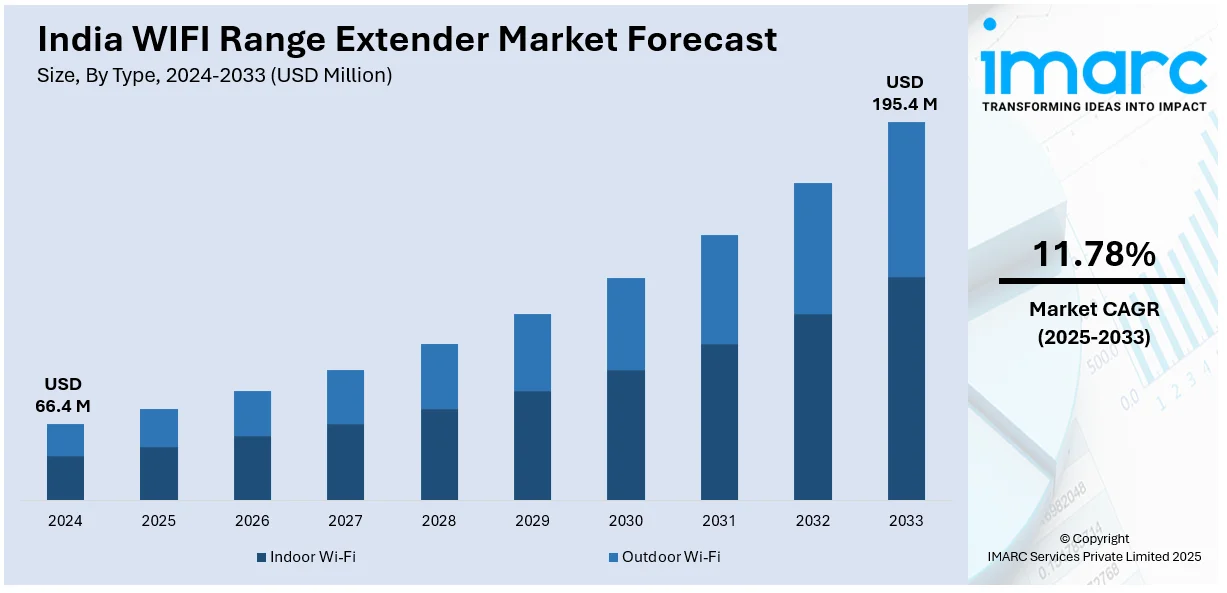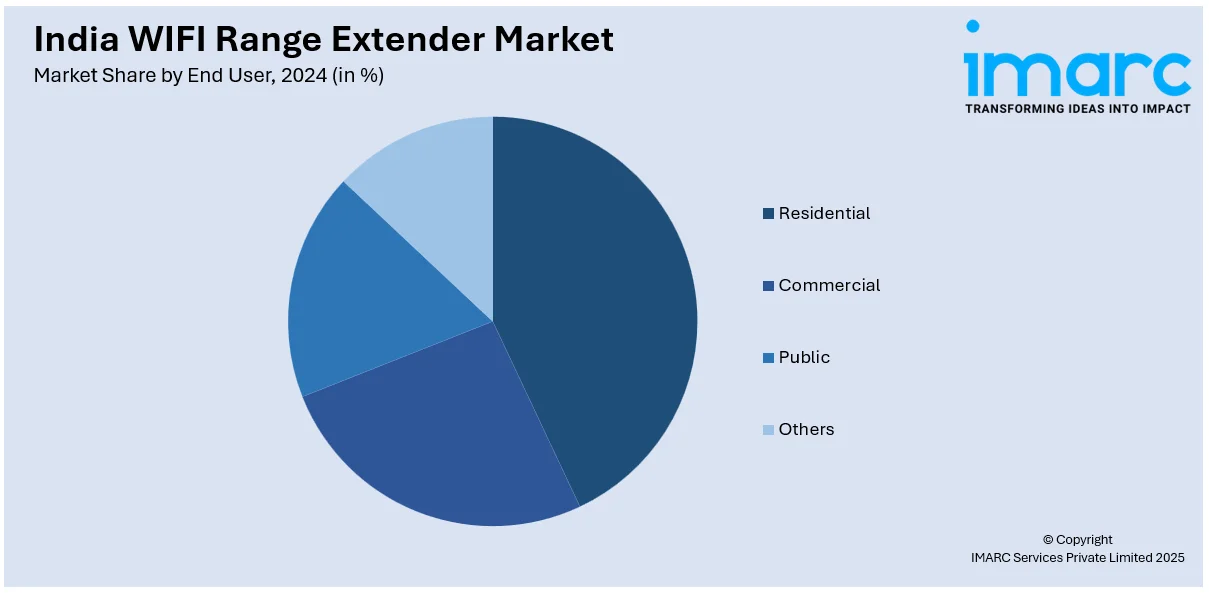
India WIFI Range Extender Market Size, Share, Trends and Forecast by Type, Product, End User, and Region, 2025-2033
India WIFI Range Extender Market Overview:
The India WIFI range extender market size reached USD 66.4 Million in 2024. Looking forward, IMARC Group expects the market to reach USD 195.4 Million by 2033, exhibiting a growth rate (CAGR) of 11.78% during 2025-2033. Expanding smart home usage and IoT devices and rising internet penetration is strengthening the market growth. Moreover, the growing urbanization and high-rise living is further influencing the India WIFI range extender market share.
|
Report Attribute
|
Key Statistics
|
|---|---|
|
Base Year
|
2024 |
|
Forecast Years
|
2025-2033
|
|
Historical Years
|
2019-2024
|
| Market Size in 2024 | USD 66.4 Million |
| Market Forecast in 2033 | USD 195.4 Million |
| Market Growth Rate 2025-2033 | 11.78% |
India WIFI Range Extender Market Trends:
Rising Internet Penetration
Increasing broadband adoption across urban and rural areas is driving higher demand for seamless network coverage. Government initiatives like BharatNet are improving connectivity in remote locations, catalyzing wireless fidelity (Wi-Fi) device adoption. More households and businesses are subscribing to high-speed internet, requiring solutions to eliminate weak signal zones. As internet users grow, uninterrupted and high-quality connectivity is becoming essential. Many urban homes and offices have multiple internet users, creating network congestion and connectivity issues. Wi-Fi range extenders help distribute signals efficiently, enhancing network performance across larger spaces. The rapid digital transformation in India is increasing reliance on the internet for work, education, and entertainment. A surge in online gaming, video streaming, and smart home devices is further driving the Wi-Fi expansion need. Growing smartphone and laptop usage is also increasing bandwidth usage, making range extenders necessary. The affordability of broadband plans is encouraging more customers to upgrade their home internet infrastructure. In March 2025, Elon Musk’s Starlink announced partnerships with Bharti Airtel and Reliance Jio to improve internet connectivity in India, especially in rural areas. By integrating satellite technology with existing networks, this initiative aims to meet the rising demand for reliable internet services, supporting India WIFI range extender market growth.

To get more information of this market, Request Sample
Expanding Urbanization and High-Rise Living
Expanding urbanization and high-rise living are significantly influencing the India Wi-Fi range extender market outlook. According to the recent Economic Survey 2023-24, it is anticipated that by 2030, over 40 percent of India's population will reside in urban regions. This assessment has been derived from research and documents of NITI Aayog. This urban shift is driving the construction of multi-story buildings. These structures often create Wi-Fi dead zones, as walls and floors obstruct wireless signals across different rooms and levels. As more people shift to high-rise apartments and office complexes, the need for seamless internet connectivity is rising. Many urban households have multiple internet users relying on work-from-home (WFH), streaming, and online gaming. Poor Wi-Fi coverage in large homes and offices disrupts productivity, entertainment, and communication. Wi-Fi range extenders help overcome signal barriers by amplifying and distributing strong connectivity. The growing trend of smart homes and IoT devices is also increasing bandwidth demands across multiple floors. Smart security cameras, home assistants, and smart appliances require stable Wi-Fi signals throughout the property. Additionally, service providers are promoting Wi-Fi range extenders to enhance customer experience and reduce complaints about weak connectivity. These extenders are becoming essential in high-rise living, ensuring uninterrupted and high-speed internet access for users.
India WIFI Range Extender Market Segmentation:
IMARC Group provides an analysis of the key trends in each segment of the market, along with forecasts at the regional level for 2025-2033. Our report has categorized the market based on type, product, and end user.
Type Insights:
- Indoor Wi-Fi
- Outdoor Wi-Fi
The report has provided a detailed breakup and analysis of the market based on the type. This includes indoor Wi-Fi and outdoor Wi-Fi.
Product Insights:
- Extenders and Repeaters
- Access Points
- Antennas
A detailed breakup and analysis of the market based on the product have also been provided in the report. This includes extenders and repeaters, access points, and antennas.
End User Insights:

- Residential
- Commercial
- Public
- Others
The report has provided a detailed breakup and analysis of the market based on the end user. This includes residential, commercial, public, and others.
Regional Insights:
- North India
- South India
- East India
- West India
The report has also provided a comprehensive analysis of all the major regional markets, which include North India, South India, East India, and West India.
Competitive Landscape:
The market research report has also provided a comprehensive analysis of the competitive landscape. Competitive analysis such as market structure, key player positioning, top winning strategies, competitive dashboard, and company evaluation quadrant has been covered in the report. Also, detailed profiles of all major companies have been provided.
India WIFI Range Extender Market News:
- In September 2024, Consistent Infosystems launched the Velocity CT-4GR TAW6 router in India, featuring Wi-Fi 6, 5G SIM support, and dual-band connectivity (2.4GHz and 5GHz). It supported up to 32 users and includes Router, Access Point, and Range Extender modes. With beamforming technology and a 5dB triple antenna, it enhanced Wi-Fi coverage, catering to homes and offices.
- In January 2023, Consistent Infosystems introduced a dual-band Wi-Fi router with Ethernet and GSM support in India. The device featured 2.4GHz and 5GHz bands, ensuring better connectivity and extended coverage. With a range extender mode, it amplified Wi-Fi signals, improving network reach for homes and offices. The router catered to users seeking seamless internet access across multiple devices.
India WIFI Range Extender Market Report Coverage:
| Report Features | Details |
|---|---|
| Base Year of the Analysis | 2024 |
| Historical Period | 2019-2024 |
| Forecast Period | 2025-2033 |
| Units | Million USD |
| Scope of the Report |
Exploration of Historical Trends and Market Outlook, Industry Catalysts and Challenges, Segment-Wise Historical and Future Market Assessment:
|
| Types Covered | Indoor Wi-Fi, Outdoor Wi-Fi |
| Products Covered | Extenders and Repeaters, Access Points, Antennas |
| End Users Covered | Residential, Commercial, Public, Others |
| Regions Covered | North India, South India, East India, West India |
| Customization Scope | 10% Free Customization |
| Post-Sale Analyst Support | 10-12 Weeks |
| Delivery Format | PDF and Excel through Email (We can also provide the editable version of the report in PPT/Word format on special request) |
Key Benefits for Stakeholders:
- IMARC’s industry report offers a comprehensive quantitative analysis of various market segments, historical and current market trends, market forecasts, and dynamics of the India WIFI range extender market from 2019-2033.
- The research report provides the latest information on the market drivers, challenges, and opportunities in the India WIFI range extender market.
- Porter's five forces analysis assist stakeholders in assessing the impact of new entrants, competitive rivalry, supplier power, buyer power, and the threat of substitution. It helps stakeholders to analyze the level of competition within the India WIFI range extender industry and its attractiveness.
- Competitive landscape allows stakeholders to understand their competitive environment and provides an insight into the current positions of key players in the market.
Key Questions Answered in This Report
The WIFI range extender market in India was valued at USD 66.4 Million in 2024.
The India WIFI range extender market is projected to exhibit a CAGR of 11.78% during 2025-2033, reaching a value of USD 195.4 Million by 2033.
The India WIFI range extender market is driven by rising internet penetration, growing reliance on remote work and online education, and increased adoption of smart home devices. Consumers seek seamless connectivity across larger spaces, are also boosting demand for affordable, easy-to-install solutions that enhance network coverage and eliminate dead zones.
Need more help?
- Speak to our experienced analysts for insights on the current market scenarios.
- Include additional segments and countries to customize the report as per your requirement.
- Gain an unparalleled competitive advantage in your domain by understanding how to utilize the report and positively impacting your operations and revenue.
- For further assistance, please connect with our analysts.
 Request Customization
Request Customization
 Speak to an Analyst
Speak to an Analyst
 Request Brochure
Request Brochure
 Inquire Before Buying
Inquire Before Buying




.webp)




.webp)












